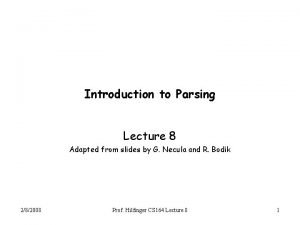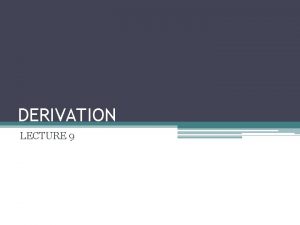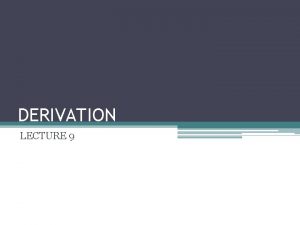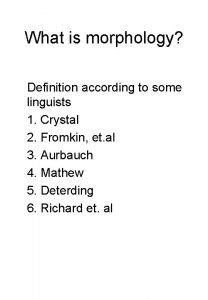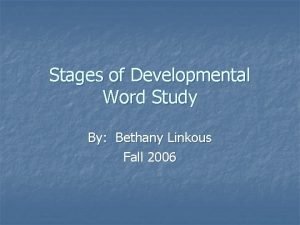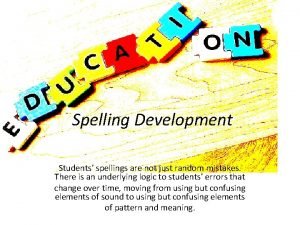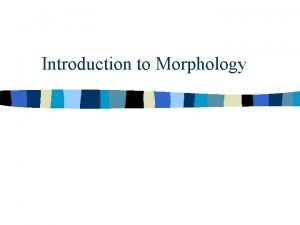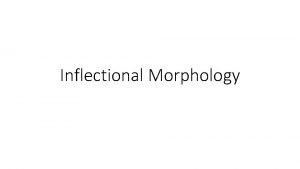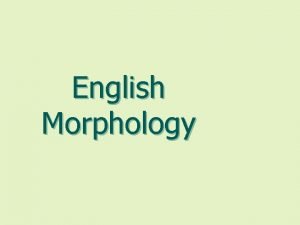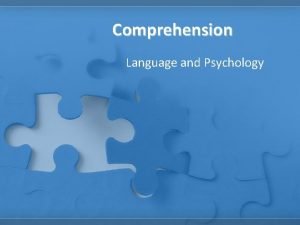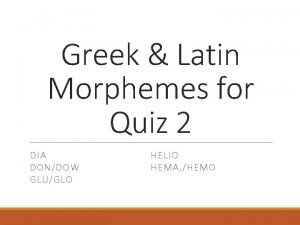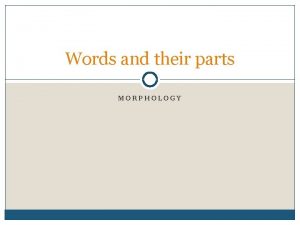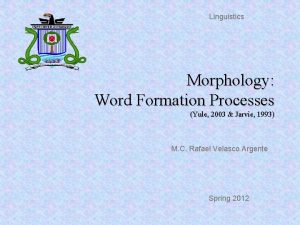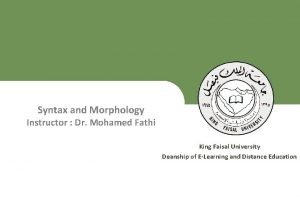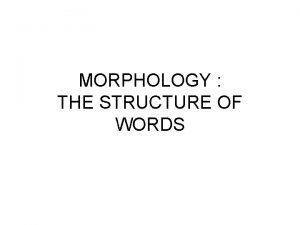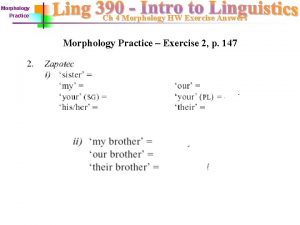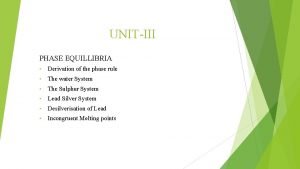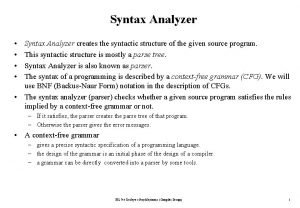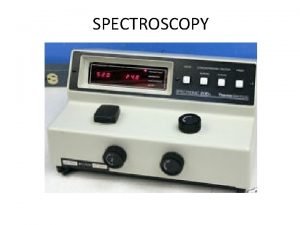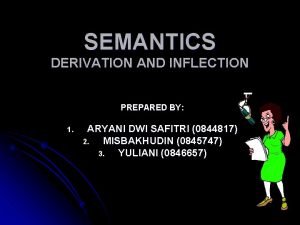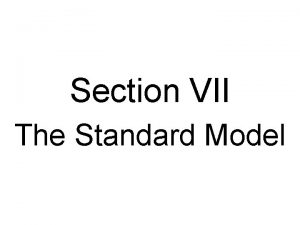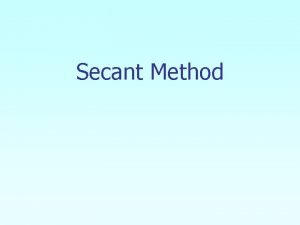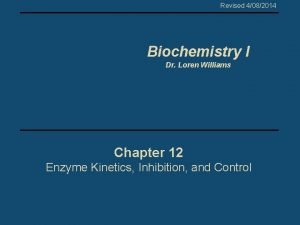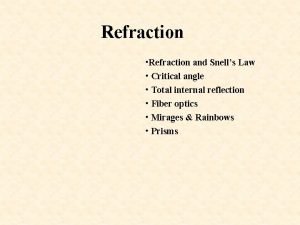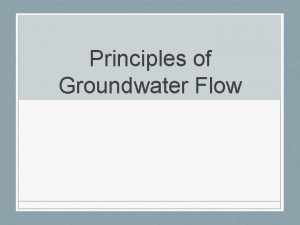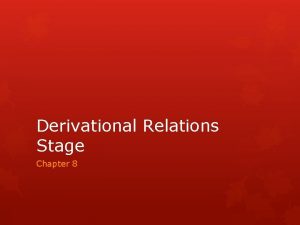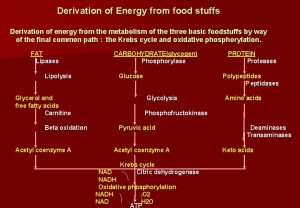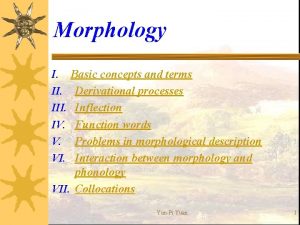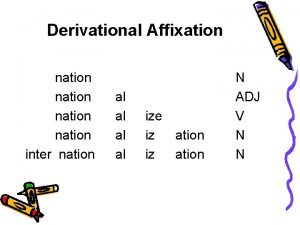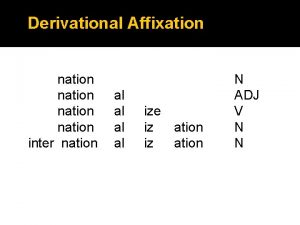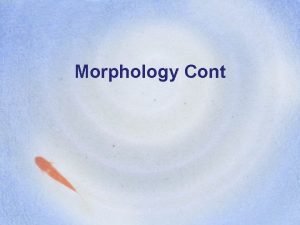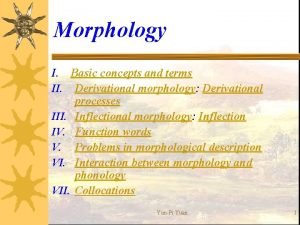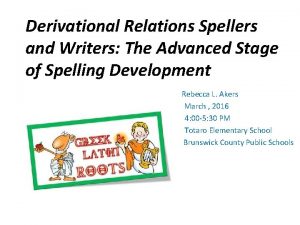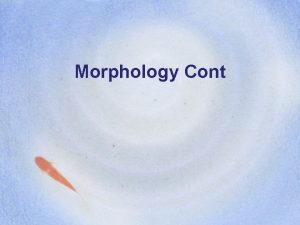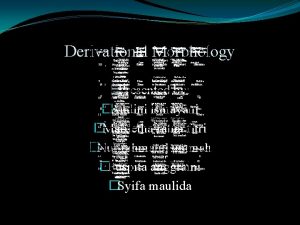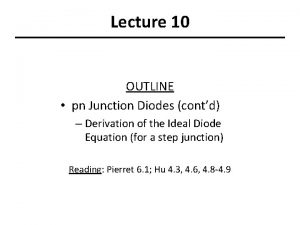DERIVATION LECTURE 9 Derivation I Derivational Structure II





































- Slides: 37

DERIVATION LECTURE 9

Derivation I. Derivational Structure. II. Derivational Relations. III. Derivational Bases. 3. 1. Structural Classification of Derivational Bases. IV. Derivational Affixes. 4. 1. Semantic Characteristics of Derivational Affixes. 4. 2. Semi-affixes. V. Derivational Patterns. 5. 1. Structural-semantic Classification of Derivational Patterns.

I. DERIVATIONAL STRUCTURE • Word-derivation in morphology is a wordformation process by which a new word is built from a stem – usually through the addition of an affix – that changes the word class and / or basic meaning of the word.

Derivational structure - the nature, type and arrangement of the ICs of the word. Prefixational derivative Unmistakable - the prefixational morpheme is added to the sequence of the root and suffixational morphemes. Un- and -mistakable = ‘not mistakable’ Suffixational derivative Discouraging – the suffixational morpheme is added to the combination of the prefixational and the root morphemes. Discourage- and –ing = ‘something that discourages’.

II. DERIVATIONAL RELATIONS • Derivational relations are the relations between words with a common root but of different derivational structure. • According to the derivational structure all words fall into two big classes: simplexes, non-derived words and complexes or derivatives.

SIMPLEXES • are words which derivationally cannot be segmented into ICs. • The morphological stem of simple words, i. e. the part of the word which takes on the system of grammatical inflections is semantically nonmotivated and independent of other words, for example, hand, come, blue, etc.

COMPLEXES/DERIVATIVES • are words which depend on some other simpler lexical items that motivate them structurally and semantically, i. e. the meaning and the structure of the derivative is understood through the comparison with the meaning and the structure of the source word.

• Derivatives are secondary, motivated units, made up as a rule of two ICs, i. e. binary units, for example, words like • Friendliness = friendly + -ness, • Unwifely = un- + wifely, • school-masterish = schoolmaster+-ish The ICs are brought together according to specific rules of order and arrangement preconditioned by the system of the language. Derivatives are marked by the fixed order of their ICs.

DERIVATIONAL BASE • is the part of the word, which establishes connection with the lexical unit that motivates the derivative and determines its individual lexical meaning describing the difference between words in the same derivational set. • dancer, rebuilder, whitewasher - active doers of the action, is signaled by the lexical meaning of the derivational bases: dance-, rebuild-, whitewash-, which establish connection with the motivating source verb.

Differential characteristics of morphological stem and derivational base A morphological stem 1) the starting point for the forms of the word (heart – hearts) A derivational base 1) the starting point for different words (heart – hearty – heartless, heartbeat) 2) predicts the part-of-speech meaning 2) does not predict the part-of-speech of the word (daydreamer (n)) meaning of the word (daydreamer (n) from daydream (v)) 3) stands for the whole semantic 3) represents only one meaning of structure of the word, represents all the source word (glassful – a drinking lexical meanings of the word (glass vessel; glassy – smooth and shiny like (n) – 1. a hard clear substance; glass) 2. a small container for drinking out of; 3. attractive objects made of glass; 4. mirror; 5. a barometer)

3. 1. STRUCTURAL CLASSIFICATION OF DERIVATIONAL BASES • 1. Bases that coincide with morphological stems, for example, dutifully; to daydream, daydreamer; • Stems that serve as this class of bases may be of different derivational types thus forming derivational bases of different degrees of complexity: 1. simple stems, which consist of only one, semantically non-motivated constituent: pocket, motion, retain;

2. derived stems, which are semantically and structurally motivated. They are binary: girlish, girlishness. The derived stem of the word girlish is girl, whereas the derived stem of the word girlishness – girlish-;

3. compound stems are always binary and semantically motivated, but unlike the derived stems both ICs of compound stems are stems themselves: match-box (two simple stems), letter-writer (one simple and one derived stem); aircraft-carrier ( a compound and derived stem).

2. Bases that coincide with word-forms: unsmiling, paper-bound. • This class of bases is represented by verbal wordforms the present and the past participles. The collocability of this class of derivational bases is confined to: a) a few derivational affixes such as the prefix un- and the suffix –ly: unnamed, unknown; smilingly, knowingly; b) other bases which coincide only with nominal and adjectival stems: mocking-bird, dancing -girl, ice-bound, easygoing.

3. Bases they coincide with wordgroups: flat-waisted, second-rateness. • Bases of this class allow a rather limited range of collocability. • They are mostly combined with derivational affixes in the class of adjectives and nouns: blue-eyed, long-fingered, old-worldish. Free word-groups make up the greater part of this class of bases.

IV. DERIVATIONAL AFFIXES are Immediate Constituents of derived words in all parts of speech. Semantically derivational affixes are characterized by a unity of • part-of-speech meaning, • lexical meaning, • differential meaning; • distributional meanings.

Derivational affixes have two basic functions: 1. stem building which is common to all affixational morphemes: derivational and non-derivational, cf. : -sh in the words girlish, greyish and –ish in the words publish, distinguish;

2. word-building, this is the function of repatterning a derivational base and thus forming new words. The repatterning may result in transferring a derivational base into the stem of another part of speech, for example, the derivational suffix –ness in the words friendliness and girlishness repattern the adjectival derivational bases friendly-, girlish- into the noun stems.

4. 1. SEMANTIC CHARACTERISTICS OF DERIVATIONAL AFFIXES • The part-of-speech meaning is proper to derivational suffixes and prefixes in different degrees. • Prefixes like en-, de-, out-, un-, be- possess the part-of-speech meaning and function as verb classifiers, for example, enlarge, deice, unhook, befriend. • The prefix over- evidently lacks the part-ofspeech meaning and is freely used both for verbs and adjectives, for example, oversleep, overeat, over-confident, over-worried.

The lexical meaning in derivational affixes may be viewed at different levels: 1. the lexical meaning of a generic type proper to a set of affixes, forming a semantic subset. The meaning of resemblance found in the suffixes –ish, -like, -y, -ly (spiderish, spiderlike, spidery); The meaning of abstract quality conveyed by the suffixes –ness, -ty (blindness, equality); The meaning of absence conveyed by the prefix un- and the suffix –less (unclean, unlucky, speechless, heartless);

2. an individual lexical meaning shared by no other affix. The suffixes –ish, -like, -y all have the meaning of resemblance but –like conveys an overall resemblance, -ish conveys likeness to the most typical qualities of the object; -y conveys likeness to outer shape, form, size of the object.

• Derivational affixes may be monosemantic, for example, the prefix omni- meaning ‘all’ (omnipresence, omniscience), and polysemantic, for example, the suffix –less meaning ‘lacking smth’ (brainless, endless) and ‘exceeding a category’ (timeless, countless).

4. 2. SEMI-AFFIXES • - are elements which stand midway between roots and affixes. • These are morphemes whose derivational function does not allow one to refer them either to derivational affixes or to bases, e. g. , half- in the word half-done, half-broken; self- in the words self-made, self-interest; ill- in the word ill-dressed, ill-behaved. On the one hand, these morphemes retain certain lexical ties with the root-morphemes of independent words, on the other hand, they function as derivational prefixes.

V. DERIVATIONAL PATTERNS • DP is a regular meaningful arrangement, a structure that imposes rigid rules on the order and the nature of the derivational bases and affixes that may be brought together. • Small letters v, n, a, d, num stand for the bases which coincide with the stems of the respective parts of speech: verbs, nouns, adjectives, adverbs; • ved, ving stand for the bases which are the past and present participles respectively. • In words of the long-fingered or sit-inner type the derivational bases are represented by bracketed symbols of the parts of speech making up the corresponding collocations, for example (a+n)+ +ed), (v+d) + er.

5. 1. STRUCTURAL-SEMANTIC CLASSIFICATION OF DERIVATIONAL PATTERNS 1. at the level of structural types patterns are known as structural formulas. They specify only the class membership of ICs and the direction of motivation, such as a+sf → N, prf +n → V, prf + n → N, n + sf → V, etc. •

In terms of patterns of this type, all words may be classified into four classes: 1. suffixal derivatives: friendship, glorified, blackness, skyward, etc. ; 2. prefixal derivatives: rewrite, exboxer, non-smoker, un-happy, etc. ; 3. conversions: a cut, to parrot, to winter, etc. ; 4. compound words: key-ring, musiclover, wind-driven, etc.

2. at the level of structural patterns which specify the base classes and individual affixes thus indicating the lexical-grammatical and lexical classes of derivatives within certain structural classes of words. The affixes refer derivatives to specific parts of speech and lexical subsets as, for example, DP n + ish → A signals a set of adjectives with the lexical meaning of resemblance, for example, boyish, girlish, womanish, whereas a + -ish → A signals adjectives meaning a small degree of quality, for example, pinkish, whitish, wildish, etc.

3. at the level of structural-semantic patterns the latter specify semantic peculiarities of bases and individual meanings of affixes. The nominal bases in the pattern n+-ess → N are confined to nouns having in their semantic structures a component ‘a male animate being’: lioness, traitress, stewardess, etc. ; The nominal bases in n+-ful 2 → N are limited by nouns having a semantic component ‘container’: lungful, carful, mouthful, whereas in n+ -ful 1 → A the nominal bases are confined to nouns of abstract meaning.

6. HISTORICAL CHANGEABILITY OF WORDSTRUCTURE 1. Process of simplification: a. root-morphemes may turn into affixational or semi-affixational morphemes; b. polymorphic words may become monomorphic; c. compound words may be transformed into derived or even simple words. E. g. friendship – frēōndscipe; husband – hus-bond-a; cupboard [k 0 bqd]

Summary and Conclusions 1. Derivational level of analysis aims at finding out the derivative types of words, the interrelation between them and at finding out how different types of derivatives are constructed.

2. Derivationally all words form two structural classes: simplexes, i. e. simple, non-derived words and complexes, or derivatives. Derivatives fall into: suffixal derivatives, prefixal derivatives, conversions and compounds. The relative importance of each structural type is conditioned by its frequency value in actual speech and its importance in the existing word-stock.

3. Each structural type of complexes shows preference for one or another part of speech. Within each part of speech derivative structures are characterised by a set of derivational patterns. 4. The basic elementary units of the derivative structure are: derivational bases, derivational affixes, derivational patterns.

5. Derivational bases differ from stems both structurally and semantically. Derivational bases are built on the following language units: a) stems of various structure, b) wordforms, c) word-groups or phrases. Each class and subset of bases has its own range of collocability and shows peculiar ties with different parts of speech.

6. Derivational affixes form derived stems by repatterning derivational bases. Semantically derivational affixes present a unity of lexical meaning and other types of meaning: functional, distributional and differential unlike non-derivational affixes which lack lexical meaning.

7. Derivational patterns (DP) are meaningful arrangements of various types of ICs that can be observed in a set of words based on their mutual interdependence. DPs can be viewed in terms of collocability of each IC. There are two types of DPs — structural that specify base classes and individual affixes, and structuralsemantic that specify semantic peculiarities of bases and the individual meaning of the affix.

• DPs of different levels of generalisation signal: 1. 1) the class of source unit that motivates the derivative and the direction of motivation between different classes of words; 2. 2) the part of speech of the derivative; 3. 3) the lexical sets and semantic features of derivatives.

REFERENCES: 1. Gunzburg R. Z. A Course in Modern English Lexicology, M. , 1979. 2. Zykova I. V. Practical Course of English Lexicology, M. , 2006.
 Leftmost derivation and rightmost derivation
Leftmost derivation and rightmost derivation Derivational base
Derivational base Derivational structure
Derivational structure 01:640:244 lecture notes - lecture 15: plat, idah, farad
01:640:244 lecture notes - lecture 15: plat, idah, farad Derivational relations stage
Derivational relations stage Morphology definition
Morphology definition Derivational relations stage
Derivational relations stage Derivational relations stage
Derivational relations stage Lexical universals
Lexical universals Inflectional infix
Inflectional infix What is inflectional and derivational morphology
What is inflectional and derivational morphology Derivational thinking
Derivational thinking Examples of morphemes
Examples of morphemes Derivational relations stage
Derivational relations stage Derivational theory of complexity
Derivational theory of complexity Content words examples
Content words examples Inflectional and derivational morphemes quiz
Inflectional and derivational morphemes quiz Word classes exercises
Word classes exercises What is the word according to leonard bloomfield?
What is the word according to leonard bloomfield? Proloferated
Proloferated Derivational affixes
Derivational affixes Classification of morphemes
Classification of morphemes Derivational and inflectional morphemes
Derivational and inflectional morphemes Derivational morphology
Derivational morphology English morphology exercises with answers
English morphology exercises with answers Allomorph examples
Allomorph examples Gibbs phase rule derivation
Gibbs phase rule derivation Chezy formula
Chezy formula Derivation of e
Derivation of e Beer lambert law
Beer lambert law Suffix educate
Suffix educate Yukawa potential derivation
Yukawa potential derivation Secant method
Secant method Chezy equation
Chezy equation Michaelis-menten equation derivation
Michaelis-menten equation derivation Snell's law derivation class 10
Snell's law derivation class 10 Divide
Divide Derive permutation formula
Derive permutation formula
